Leadership vs. Management: What’s the Difference? [With Best Practices for Employee Engagement]

Sorry, there were no results found for “”
Sorry, there were no results found for “”
Sorry, there were no results found for “”
Do leadership and management mean the same thing to you? Don’t worry; you’re not the only one! However, this is certainly not another potAto-potatO situation since the two terms are anything but synonymous.
While both concepts focus on empowering employees and achieving organizational goals, the main difference between leadership and management lies in their individual functions. For instance, leadership skills are about influencing others, while management skills involve implementing processes with coordination and control.
In this article, we’ll discuss leadership vs. management and shed light on their fundamental differences on an organizational level. We’ll also explore:
Have you ever felt motivated by another person’s words or actions? Say, by a fitness and productivity influencer who’s all about eating healthy, preparing homemade meals, and going to the gym three times a week! 🏋️
Leaders inspire you in a similar fashion—their actions and behavior give a group of people the extra motivation boost to keep going and achieve collective goals. Many associate leadership with high positions in a company, such as the chief executive officer (CEO) or strategist, but the concept is more about having the social influence and growth mindset to encourage people to take action (as against forcing them into it).
Leaders tend to focus on the big picture and leverage networking and team-building aspects to move ahead. They keep the company’s mission in mind and invite every team member to contribute toward their strategic vision.
Any top leadership role is about inspiring team loyalty and morale, which might sound vague. However, a good leader comes with the following four concrete skills that help them guide teams:
Effective leaders provide vision to their team, which can be translated into actionable plans that determine the employees’ everyday workflows. The vision can be a long-term desired outcome, such as creating an innovative software tool, revamping the company culture, or expanding operations globally.
Tip: Leaders with a clear vision need to think ahead and define actionable strategies on what buttons to push to reach the finish line. One way to do that is to use the free ClickUp Vision to Values Template. It offers step-by-step support to leaders as they convert vision and mission statements into measurable goals and objectives to guide the planning team.
Imagine someone storming into your office saying: Guys, let’s work harder and release the software by the end of the month. Does that make them a great leader? No!
The X factor of efficient leadership is the capacity to inspire people—leaders are well-versed in using the right messaging and delivery to motivate all their employees to achieve desired results.
A leader’s job is to ignite passion in their team by making them feel valued and reminding each team member of their strengths. The idea is to give everyone a sense of accomplishment that drives them to take ownership of their tasks. This way, an effective leader can transfer their energy and enthusiasm onto the team as they push toward team goals. 💪
A great leader moves away from the status quo and strives and fights for improvements, whether within the industry or their own company. This often means thinking outside the box and finding innovative ways to:
Bonus read: Check out 10 strategies to become a successful change leader! 🌻
Strong leaders develop outstanding emotional intelligence over time. They understand and read their team’s emotions like a book. Over time, they even learn how to maneuver those emotions to navigate what an employee wants and suggest mutually beneficial ways to get there.
In contrast, a lack of emotional intelligence can result in misunderstandings and decrease team motivation. That’s precisely why an effective leader handles interpersonal relationships, team conflicts, and tense client situations with a solution-centric approach. Examples include:
Efficient and smart leadership is the key to triggering changes in all spheres, whether politics, entertainment, or climate change. 🔑
For example, Abraham Lincoln displayed stellar leadership skills in the political sphere. His persuasive oratory skills and commitment to freedom-centric core values were crucial as he led the United States during the Civil War.
While Lincoln was courteous to his opponents, his single-minded approach gave him an edge during conflict-prone discussions. His leadership efforts earned the support of the American people and eventually led to the abolishment of slavery, making him a symbol of human dignity and democracy around the world.
Moving to the business realm, let’s put the spotlight on someone who enjoyed an incomparable run in the entertainment industry—Walt Disney. His leadership strategy was simple—value your team and involve them in every decision. He was people-oriented and ensured his team understood his vision. Disney was also known for intelligent risk-taking—he wasn’t afraid of innovative changes but was wise enough to pick his battles. This leadership attitude helped him build an entertainment empire that continues to thrive.
A manager’s role revolves around planning, organizing, and adjusting day-to-day tasks and operations, as well as coordinating teams to achieve objectives. They are doers—the ones who execute the leader’s vision and work closely with teams to optimize resources, organize processes, and knock tasks off the collective to-do list.
Good managers prioritize delivering results based on preset goals, be it improved productivity, enhanced job satisfaction, or optimized resources. Team members follow the manager’s orders, not necessarily because of their inspirational personality or friendliness, but because they have to respect the team hierarchy.
Let’s explore the four essential skills for effective management:
Organizational mastery is one of the most important management qualities that compliments leadership. A manager is expected to break down projects into granular tasks and create and manage schedules, considering resources like time, money, and team availability.
Of course, organizational skills are not something you’re born with. Great managers typically rely on scheduling tools and templates to help them out. For instance, the ClickUp Team Schedule Template, with its real-time calendars and visual workload maps, is the go-to scheduling aid for many managers.
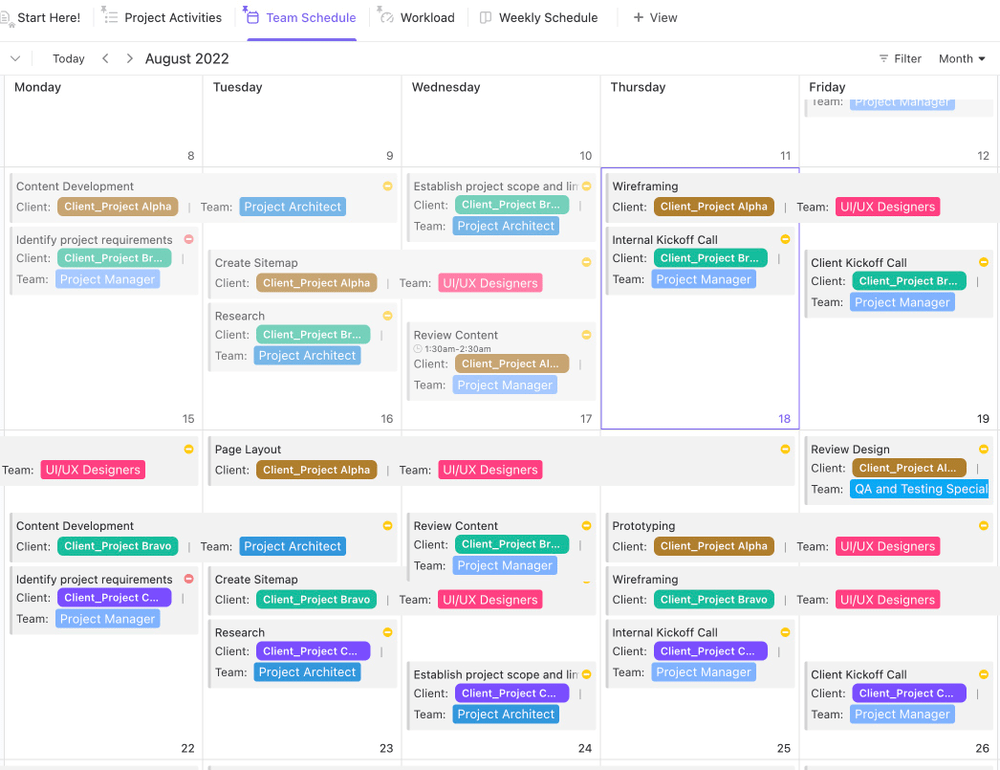
A manager’s job is to keep track of what is to be done and when. So, another important skill they develop is making adjustments on the fly to accommodate resource changes and crisis situations.
The essence of adaptability in a managerial role can be summed up as accountability. A manager has to hold themselves accountable for ensuring the end goals—like a project delivery or planned event—are achieved despite challenges.
They typically cultivate adaptability by understanding teams’ work styles and process logistics, predicting risks, and maintaining healthy two-way communication channels that help employees be more receptive to change.
Most management roles require a robust organizational structure that enables professional development and easy employee retention.
A good manager is not just there to assign tasks to their team and take off until the project is completed—they constantly monitor performance and analyze KPIs to identify potential quality bottlenecks, provide feedback, and take corrective measures to strengthen their team.
A great manager is one who is decisive. If your team is stuck on a problem, you cannot back out with a weak excuse like: I don’t know; figure it out. 🤷
Let’s say you have to expedite a product launch. Your job here is to make decisions to minimize operational friction. Now, you can ask your team for input. Still, ultimately, it’s you who has to check available resources and existing workloads, prioritize tasks, and maybe even pull people from other projects to get all hands on deck to commit to the tighter deadline.
Additionally, managers must communicate decisions on time, hold space for suggestions, and offer reasoning to boost transparency within teams.
Tip: Not every manager has the time to dedicate to elaborate decision-making processes. Luckily, you can use the ClickUp Decision Tree Template to visualize the risks and opportunities attached to various solutions and arrive at decisions faster.⚡
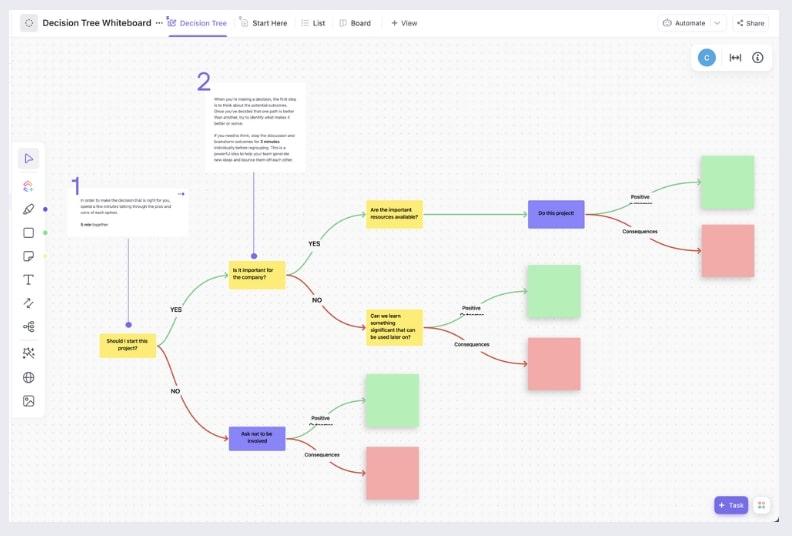
An enlightening example of successful management that grew into fantastic leadership is the case of Andrew Cherng, the founder of the Panda Express restaurant chain.
Cherng opened the first restaurant in 1973 and has since expanded his empire to over 2,400 restaurants across the U.S! His success can be attributed to his people-first management style and passion for continuous learning and improvement.
Cherng also actively invests in his employees and pushes the chain’s newer managers to offer the best service based on three principles:
Leadership and management in business are like a violin and a viola in a symphony orchestra—they’re kind of similar but have distinctive features that allow them to play unique roles. 🎻
Let’s dig into some important management vs. leadership differences:
The best leaders are visionaries—they’re always one step ahead, thinking about where they want to be in the future and creating a game plan to get there.
However, great leaders aren’t unrealistic with their vision. They’re aware of process limitations and inspire people to perform despite such shortcomings. They focus on future goals while communicating the why aspect of their vision to each team member.
On the other hand, managers are all about execution—they focus on the present and exercise authority to get tasks done. In tight situations, a manager accepts things as they are and tries to make the best of existing resources.
You could say that managers turn leadership ideas into reality.
Tip: Managers and leaders invest a lot of their time in planning the viability of a vision in terms of processes but still end up with conflicts. The best case scenario here is to brainstorm the broad-range goals and relevant process aspects side by side and proactively account for any potential roadblocks.
If you need a shared canvas to brainstorm, jump on the ClickUp Process Flow Template for rich visual workflow planning.

Leaders inspire and motivate others to achieve big-picture goals and instill a sense of purpose in teams. Research shows that effective leadership and the resulting motivation enhance job satisfaction and productivity.
But leaders aren’t concerned with controlling day-to-day operations—managers are. They implement processes and check whether all tasks are on track to achieve organizational goals. You can say that the manager’s attention is on the micro-level of things that ultimately help fulfill the company’s mission set by leaders.
As scholar Warren Bennis said: The manager administers, the leader innovates. This statement sums up an important difference between the two roles—leaders always think about improvement. They constantly pursue innovations and impactful changes that could help them solve problems and overcome challenges. The status quo is their biggest fear, and their mission is to escape it and keep climbing up the ladder. 🪜
Successful managers administer existing processes with little regard for the status quo. They care about keeping the machine running smoothly.
So, managers work toward predetermined goals using the tools already available in their toolbox. They don’t go out there searching for better tools—that’s the leaders’ job.
Bonus: The ClickUp Innovation Idea Management Template is a must-try for both leaders and managers as it not only helps manage new ideas but also supports implementation processes.
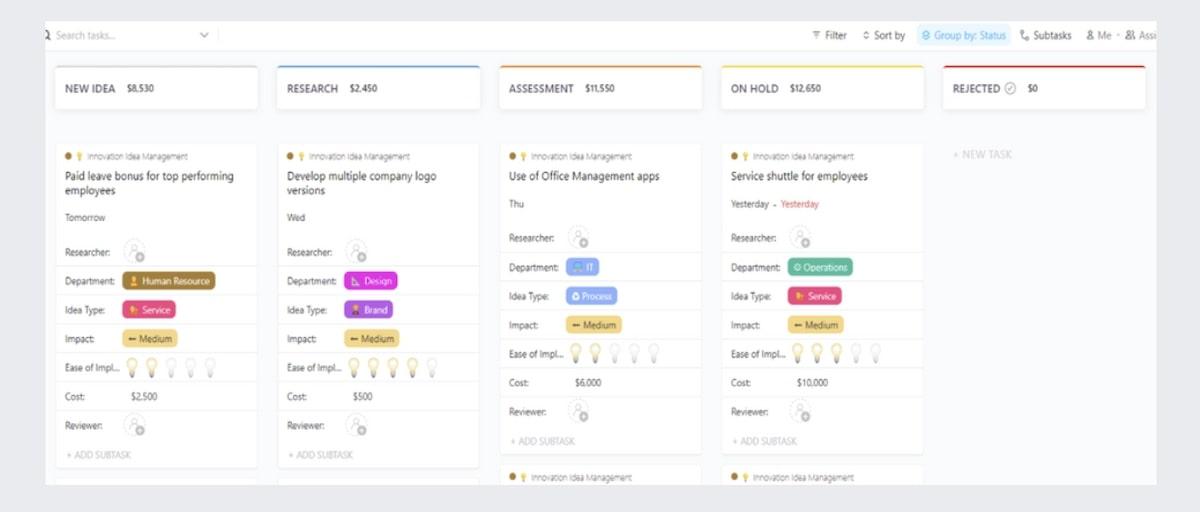
It’s not a coincidence that leadership and management are often confused and used interchangeably. The scope of these two concepts intersect in several aspects, mainly:
Leaders and managers are both employee-facing figures, albeit in different capacities. Here are three common best practices to perform either role successfully:
If you want people to respect and trust you, you must be a role model and practice what you preach. Your team observes how you operate—if you talk the talk but don’t walk the walk, they won’t be inclined to follow in your footsteps or see you as an authoritative figure.
Here are some must-have qualities to be the great managers and leaders who provide stability to their team:
Checking your team’s pulse every once in a while helps you get an idea of their satisfaction and engagement levels, which helps improve your leadership and management skills.
Practice active listening when considering your team’s perspectives and attitudes toward work or a specific decision. Pay attention to their insights about process inefficiencies, scheduling issues, and operational roadblocks, ask further questions, and develop better solutions for achieving goals and improving team dynamics.
Over the past decades, business and communication software tools have greatly influenced how leaders and managers operate. You no longer have to rely on time-consuming work like checking project statuses manually or organizing long meetings to share task details. All you need is a well-rounded work management solution to:
Our recommendation is ClickUp, an all-in-one task and project management solution with features to centralize work, streamline processes, and collaborate with teams at any scale. The platform not only supports data-backed decision making but also leaves you with more time to focus on strategizing and problem solving.
Let’s see how ClickUp aids leadership and management roles. 🌺
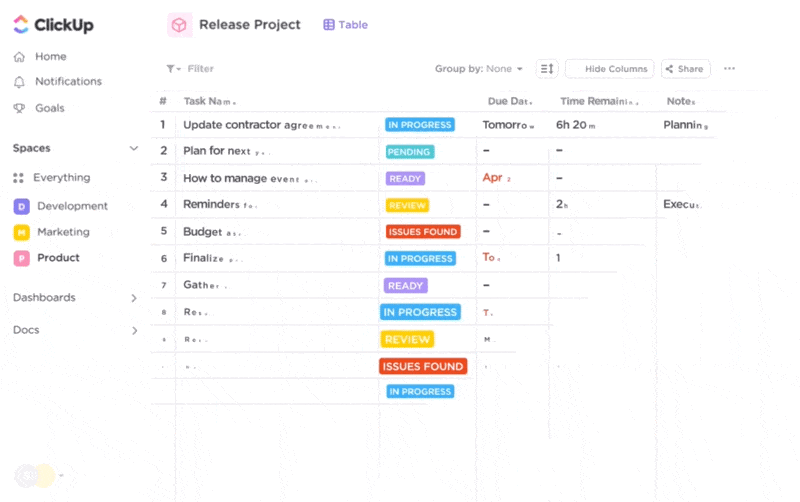
The ClickUp Project Management suite is a robust feature set that lets you create, organize, and monitor tasks, switch perspectives, set priorities, and communicate—everything a good leader or manager needs. 😎
For starters, you can empower teams by creating a centralized knowledge base in ClickUp Docs. Instead of sharing strategies, visions, and task plans through elaborate meetings, you can compile all your knowledge assets in organized Folders, allowing your employees seamless support as they carry out their tasks.
ClickUp also helps with flexible project scheduling. Use ClickUp Tasks, Calendar, and Gantt Charts to create, assign, categorize, and keep track of work in a few clicks.
Change perspectives with 15+ ClickUp views—from basic List and Board views to advanced options for visualizing workloads or project timelines. Switch views to identify inefficiencies and roadblocks ahead of time and optimize resources on the go.
You’ll appreciate collaborative communication features like ClickUp Chat and Assign Comments. Use them to exchange messages with cross-functional teams in real time without leaving the platform. Take advantage of the Mentions feature for quick shout-outs to teammates.
The idea behind these features is to help leaders and managers stay connected with their workforce effortlessly, promoting a healthier company culture and smoother decisions.
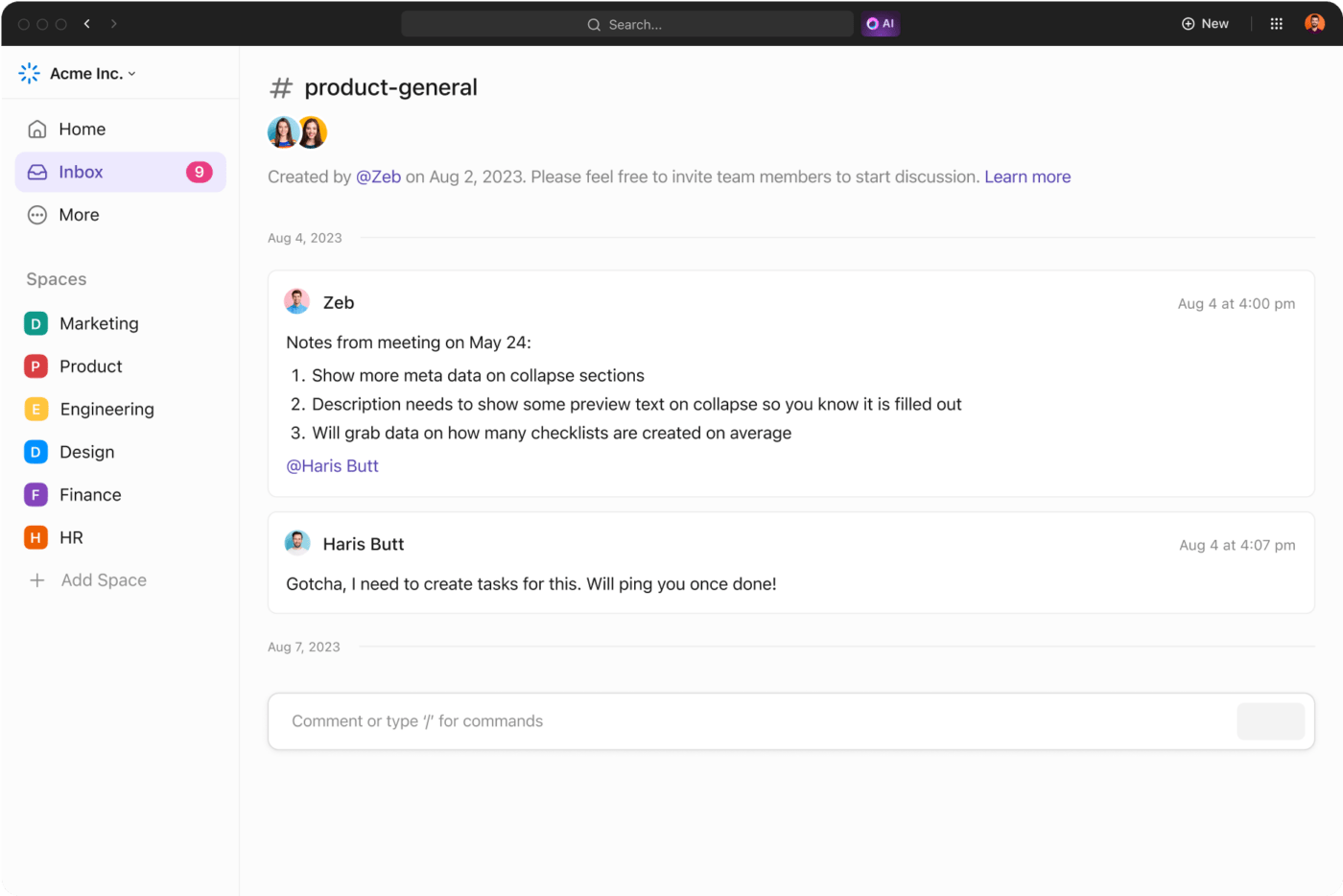
You can also use ClickUp Whiteboards to brainstorm with your team. These are digital canvases ideal for strategizing and problem solving. Use them to create bulletproof short- and long-term plans and move from ideas to reality. 🧠
Whether you’re a leader or manager (or both), you’re always working toward a goal. However, others won’t follow or trust you if your short- or long-term goals are unclear or unrealistic. With ClickUp Goals, you can set, manage, and adjust your goals, track completion percentages, and monitor delivery targets.
Choose the type of Target (Number, True/False, Currency, or Tasks) and allow ClickUp to track goals for you! Organize Goals into folders for easier navigation and control.
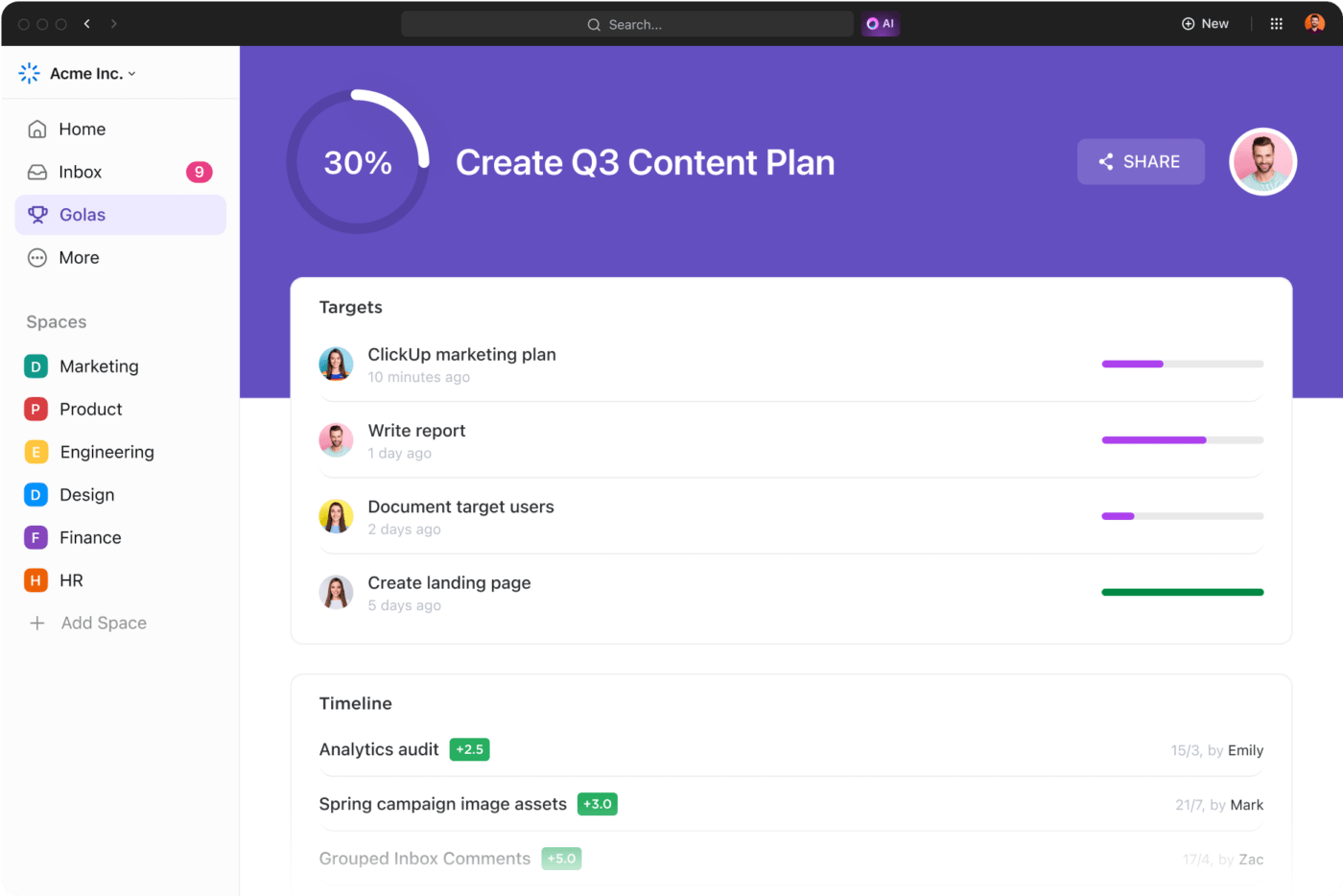
Leaders and managers should also set Milestones to define key progress points in projects. This helps them keep an eye on broad-range goals without micromanaging their employees.
Setting up custom ClickUp Dashboards is another way to monitor goals and performance metrics from afar. You can organize your Dashboard to display real-time data, like time tracked or sales made, and enjoy actionable insights throughout the day. 😏
Leading and managing teams is easier with ClickUp templates—they have pre-made sections to help you communicate consistently across various use cases and with minimal mistakes!
If you want to set clear goals and develop a productive action plan for jumpstarting your organization’s success, try ClickUp’s development plan templates. They can help you organize ideas more professionally and even explore the scope for employee growth.
If you’re expanding your leadership or management teams, plan your proposed transitions with succession planning templates. They’ll help you define roles and positions, shed light on expected responsibilities, and tailor a transparent game plan for the future. You can explore ClickUp’s library, which has over 1,000 template options for leadership and management. 💗
Leadership and management may differ in many aspects, but both functions contribute equally to organizational success. Luckily, you can leverage tools like ClickUp to carry out all kinds of tasks as a leader and manager.
With features for goal setting, communication, collaboration, and progress monitoring, ClickUp centralizes the diverse aspects of both roles and gives you complete control over your work. Sign up today and launch your company to success! ✨
© 2025 ClickUp